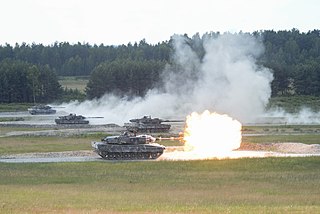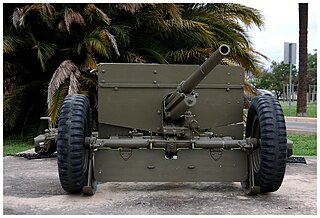Towed infantry guns
Most towed infantry guns are lightweight and capable of being manhandled for limited mobility to accompany infantry.
Infantry support guns are designed to provide direct organic support for infantry forces. They fire a range of shells, primarily in a direct fire mode.
Most towed infantry guns are lightweight and capable of being manhandled for limited mobility to accompany infantry.
A self-propelled infantry gun (assault gun) is an armored gun-armed vehicle designed to provide direct fire support for infantry and armored forces. Typically, the gun is mounted in the hull and the front of the vehicle is heavily armored.

A tank destroyer, tank hunter, tank killer, or self-propelled anti-tank gun is a type of armoured fighting vehicle, armed with a direct fire artillery gun or missile launcher, designed specifically to engage and destroy enemy tanks, often with limited operational capacities.

The BMP-1 is a Soviet amphibious tracked infantry fighting vehicle, in service 1966–present. BMP stands for Boyevaya Mashina Pyekhoty 1, meaning "infantry fighting vehicle, 1st serial model". The BMP-1 was the first mass-produced infantry fighting vehicle (IFV) of the Soviet Union. It was called the M-1967, BMP and BMP-76PB by NATO before its correct designation was known.

The Panzerkampfwagen III, commonly known as the Panzer III, was a medium tank developed in the 1930s by Germany, and was used extensively in World War II. The official German ordnance designation was Sd.Kfz. 141. It was intended to fight other armoured fighting vehicles and serve alongside and support the similar Panzer IV, which was originally designed for infantry support. However, as the Germans faced the formidable T-34, more powerful anti-tank guns were needed, and since the Panzer IV had more development potential with a larger turret ring, it was redesigned to mount the long-barrelled 7.5 cm KwK 40 gun. The Panzer III effectively swapped roles with the Panzer IV, as from 1942 the last version of the Panzer III mounted the 7.5 cm KwK 37 L/24 that was better suited for infantry support. Production of the Panzer III ceased in 1943. Nevertheless, the Panzer III's capable chassis provided hulls for the Sturmgeschütz III assault gun until the end of the war.

The M24 Chaffee was an American light tank used during the later part of World War II; it was also used in post–World War II conflicts including the Korean War, and by the French in the War in Algeria and the First Indochina War. In British service it was given the service name Chaffee after the United States Army General Adna R. Chaffee Jr., who helped develop the use of tanks in the United States armed forces. Although the M41 Walker Bulldog was developed as a replacement, M24s were not mostly removed from U.S. and NATO armies until the 1960s and remained in service with some Third World countries.

The Type 94 tankette was a tankette used by the Imperial Japanese Army in the Second Sino-Japanese War, at Nomonhan against the Soviet Union, and in World War II. Although tankettes were often used as ammunition tractors, and general infantry support, they were designed for reconnaissance, and not for direct combat. The lightweight Type 94 proved effective in China as the Chinese National Revolutionary Army had only three tank battalions to oppose them, and those tank battalions were equipped only with some British export models and Italian CV-33 tankettes. As with nearly all tankettes built in the 1920s and 1930s, they had thin armor that could be penetrated by .50 caliber machine gun fire at 600 yards (550 m) range.

The Type 97 Chi-Ha was a medium tank used by the Imperial Japanese Army during the Second Sino-Japanese War, the Battles of Khalkhin Gol against the Soviet Union, and the Second World War. It was the most widely produced Japanese medium tank of World War II.

The M18 Hellcat is a tank destroyer that was used by the United States Army in World War II and the Korean War. A top speed of up to 55 mph (89 km/h) was attained by keeping armor to a minimum, using the innovative Torqmatic automatic transmission, and by equipping the relatively light vehicle with the same main gun used on some variants of the much larger Sherman tank.

Armoured warfare or armored warfare, is the use of armored fighting vehicles in modern warfare. It is a major component of modern methods of war. The premise of armoured warfare rests on the ability of troops to penetrate conventional defensive lines through use of manoeuvre by armoured units.

The M10 tank destroyer was an American tank destroyer of World War II. After US entry into World War II and the formation of the Tank Destroyer Force, a suitable vehicle was needed to equip the new battalions. By November 1941, the Army requested a vehicle with a gun in a fully rotating turret after other interim models were criticized for being too poorly designed. The prototype of the M10 was conceived in early 1942 and delivered in April that year. After appropriate changes to the hull and turret were made, the modified version was selected for production in June 1942 as the 3-inch Gun Motor Carriage M10. It mounted a 3-inch gun M7 in a rotating turret on a modified M4 Sherman tank chassis. An alternate model, the M10A1, which used the M4A3 variant chassis, was also produced. Production of the two models ran from September 1942 to December 1943 and October 1942 to November 1943, respectively.

The M3 half-track was an American armored personnel carrier half-track widely used by the Allies during World War II and in the Cold War. Derived from the M2 half-track car, the M3 was extensively produced, with about 15,000 standard M3s and more than 38,000 variant units manufactured.

The Type 95 Ha-Gō was a light tank used by the Empire of Japan during the Second Sino-Japanese War, at Nomonhan against the Soviet Union, and in the Second World War. It proved sufficient against infantry but, like the American M3 Stuart light tank, was not designed to combat other tanks. Approximately 2,300 were produced, making it the most numerous Japanese armoured fighting vehicle of the Second World War.

The 37 mm gun M3 is the first dedicated anti-tank gun fielded by United States forces in numbers. Introduced in 1940, it became the standard anti-tank gun of the U.S. infantry with its size enabling it to be pulled by a jeep. However, the continuing improvement of German tanks quickly rendered the 37 mm ineffective and, by 1943, it was being gradually replaced in the European and Mediterranean theaters by the more powerful British-developed 57 mm gun M1. In the Pacific, where the Japanese tank threat was less significant, the M3 remained in service until the end of the war, but some 57mm guns were issued.

The 37 mm Gun Motor Carriage M6, also known as M6 Fargo, and under the manufacturer (Dodge)'s designation WC55, was a modified Dodge WC52 light truck mounting a light anti-tank gun. It was used by the United States Army for infantry support and as a mobile anti-tank gun. It operated from late 1942 to January 1945 in the Mediterranean, European, and Pacific theaters of World War II. The M6 saw limited use during the war, and was poorly suited to modern warfare as it was unarmored and was armed with a too small caliber gun. Being required to back into firing positions rather than forward firing proved to be a deficiency.

D-8 (Dyrenkov-8) was an early Soviet armored vehicle built in 1932–34. Only 60 were built; it was quickly superseded by the FAI armoured car. Both were assembled in the Izhorsky Factory near Leningrad.

The 2A28 Grom is the main armament of the BMP-1 and BMD-1 infantry fighting vehicles. It is a 73 mm low pressure smoothbore semi-automatic gun with a wedge breech block. Development of the 2A28 Grom was directly linked to that of the SPG-9 recoilless gun; both fired projectiles similar to rocket-propelled grenades.

The United States has produced tanks since their inception in World War I, up until the present day. While there were several American experiments in tank design, the first American tanks to see service were copies of French light tanks and a joint heavy tank design with the United Kingdom.

This article deals with the history and development of tanks of the Japanese Army from their first use after World War I, into the interwar period, during World War II, the Cold War and modern era.

The T30 Howitzer Motor Carriage (HMC) was a United States Army self-propelled gun used in World War II. Its design was based on requirements for an assault gun issued by the Armored Force in 1941 and it was built as an interim solution until a fully tracked design was complete.